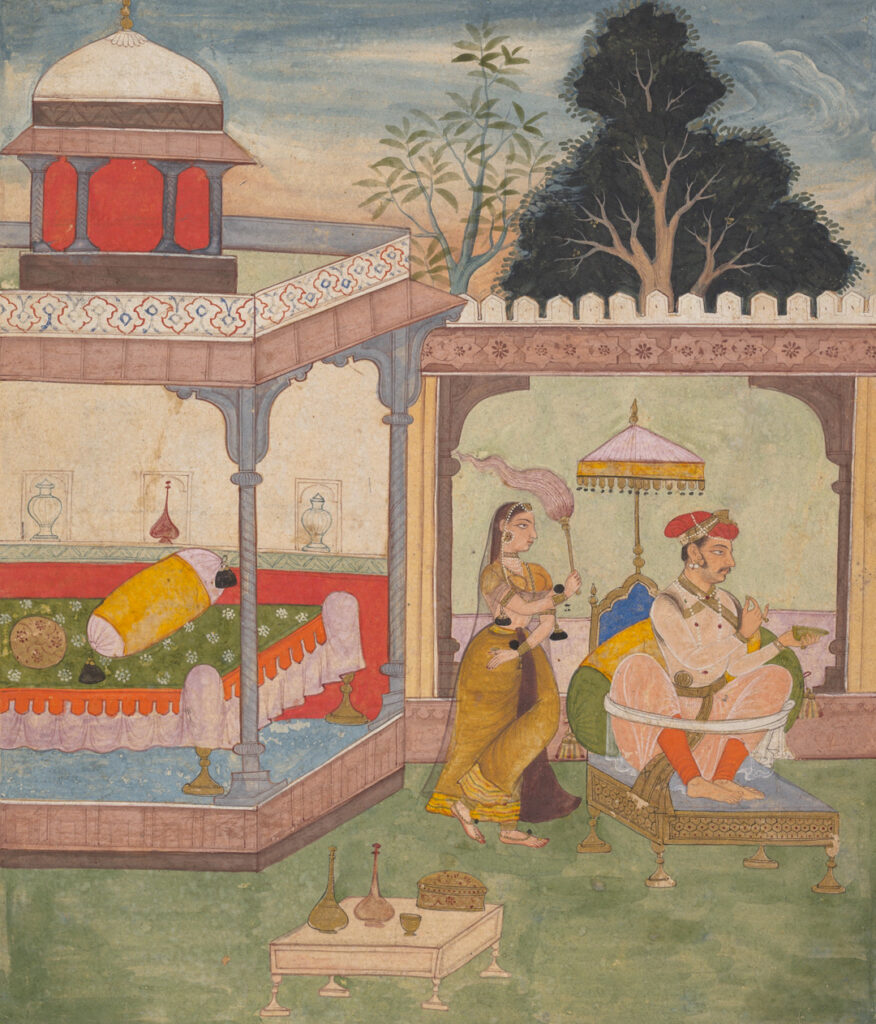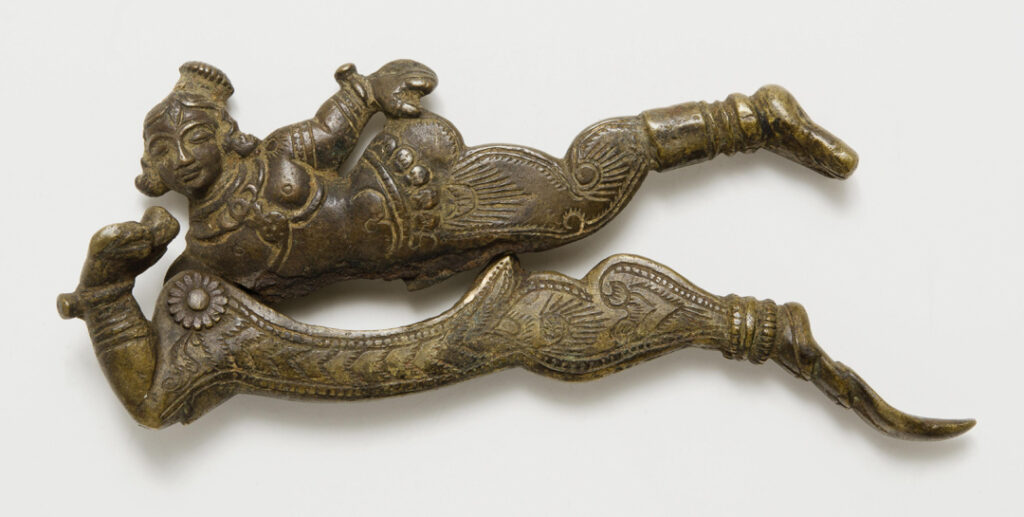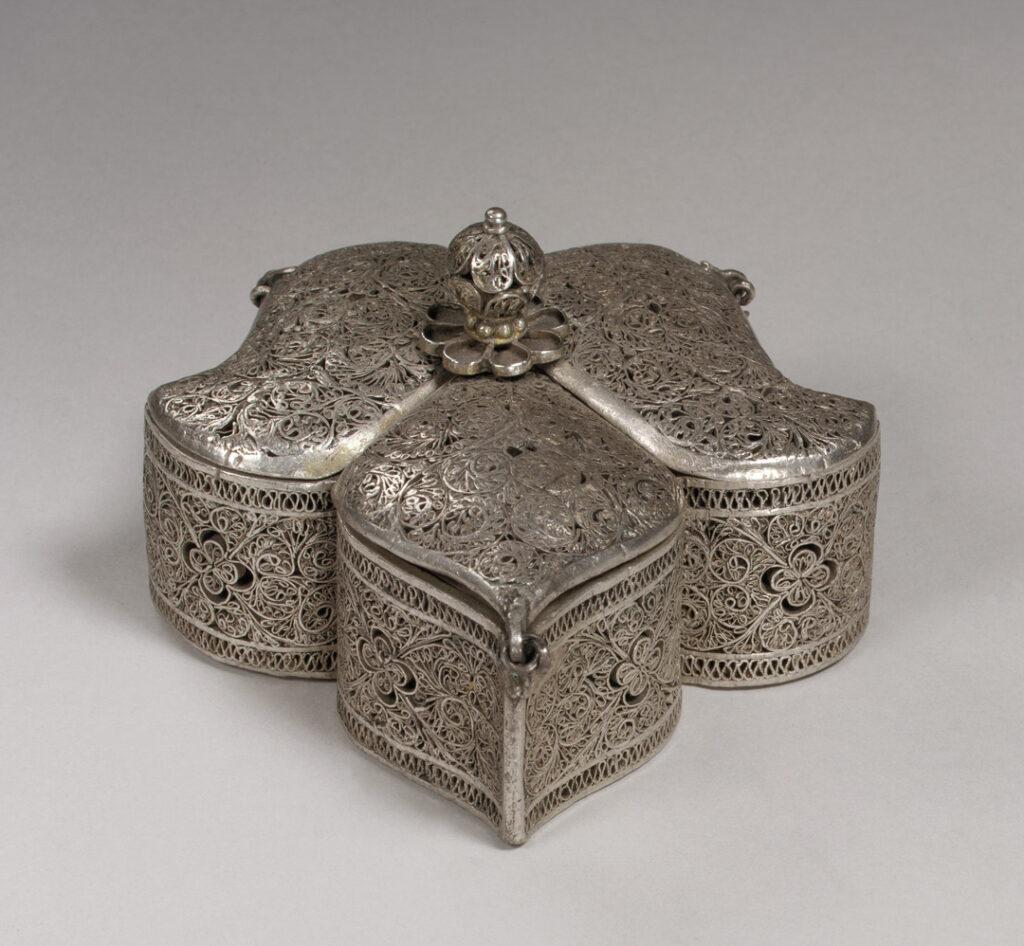The MAP Academy share the rich ornamental culture involving the consumption of paan, stuffed betel leaf, in India.
From the ubiquitous stalls dotting cities to the streaks of red juice that stain public walls and roads, the traces of paan—a stuffed betel leaf—are omnipresent in modern India. For several centuries, the consumption of paan has remained a post-meal ritual and contemporary Bollywood songs such as “Khaike Paan Benares Wala,” have been a part of the collective memory of most South Asians.
To prepare paan, the prominent veins of the dark green, heart-shaped betel leaf are trimmed before liberal amounts of slaked lime and the distinctive red herb catechu (katha) are applied to its surface. The paan is then piled with numerous ingredients ranging from the more traditional betel nut shavings, fennel seeds and gulkand (a sweet jam-like rose petal paste) to unorthodox innovations such as chocolate, cherries and mint. Deftly folded into a compact triangle, the filled paan is held in place by a clove. In the first bite, the taste of the leaf’s astringent and vegetal flavour fill the mouth. Upon biting through it, the earthy lime, the fragrant and floral gulkand and the liquorice-like fennel seed create a perfectly balanced morsel—leaving a refreshing taste.
Tracing Paan in Indian Art over the Ages
- Betel Nut Cutter with Reclining Woman, India, c. 19th century. Image courtesy of the Philadelphia Museum of Art.
- Betel Nut Cutter with Equestrian Figure, India, c. 18th century. Image courtesy of the Philadelphia Museum of Art.
While paan has been consumed as a digestive aid for centuries, there is a stark contrast between the street-side stalls selling it to the masses today and the historical objects associated with its courtly consumption. For example, an elaborate rock crystal box from eighteenth-century India that is inlaid with gold and inset with rubies was possibly used to store the slaked lime that is still applied to betel leaf today. Even betel-nut cutters assumed sculptural forms—depicting lovers wrapped in an embrace, reclining ladies and equestrian scenes. Boxes—called paan daan—that stored the ingredients used to prepare paan were often made using the bidri technique of inlaying metal on metal, in which gold or silver were hammered into intricate patterns on metal boxes. Objects such as paan daans and boxes would also be made in the shape of animals such as a duck or fish.
- Pan Box in the Shape of a Duck, Deccan, India, c. 1700. Image courtesy of The Metropolitan Museum of Art.
- Bidri Box for Holding Pan, Bidar, Deccan, India, Early–mid 17th century, Cast and engraved zinc allow, inlaid with silver and brass (bidri ware). Image courtesy of The Metropolitan Museum of Art.
- Box, India, c. 19th century. Image courtesy of The Metropolitan Museum of Art
The consumption of paan was a ritual associated with leisure and hospitality in the courtly cultures that may have commissioned some of these objects. Guests would have been offered paan, according to Mughal custom, and etiquette dictated that calling for paan would indicate the termination of a meeting. When trusted attendants were dismissed, they were offered paan as a token of goodwill. According to Pushpesh Pant, a food critic and historian, in medieval India when the sovereign dared his commanders to volunteer for a challenging mission likely to end in death, a platter full of paan was passed around and the first to pick one up was given the task.

Malavakusika Raga: Page from a Dispersed Ragmala Series (Garland of Musical Modes), Amber, Rajasthan, India, Early 17th century. Image courtesy of The Metropolitan Museum of Art.
Paintings from Mughal and Rajput courts alike underscore the importance of paan. They depict rulers at leisure, surrounded by paan daans. In the Tutinama, a manuscript made in Akbar’s court, we see a bowl of paan, along with multiple flasks of wine laid out in front of Khujasta, the protagonist, who is getting ready to meet her lover. The Nimatnama, a fifteenth-century manuscript commissioned by the Sultan of Malwa, depicts him kneeling in his night clothes, poised to take a bite out of a triangular betel leaf, while he is offered a golden bowl full of even more paan. Translated by Norah M. Titley, the manuscript claims that through paan consumption, “teeth are strengthened, diseases of the tongue, lips, gullet, throat, and windpipe are prevented, as is inflammation of the chest.”
Textual references to paan go back even further. The sixth-century Sanskrit text on medicine, Sushruta Samhita, explicitly mentions that each meal should end with paan. The Kamasutra, too, names paan as an aphrodisiac—an association depicted rather explicitly in a Rajput painting from the eighteenth century which portrays a king making love to his companion, while a golden tray for wine and paan lies on a lush carpet next to him.

A King Making Love in the Harem, Jaipur, Rajasthan, India, c. 1720–30. Image courtesy of The Cleveland Museum of Art.
According to the Kama Sutra, paan was the transition between foreplay and sex: it was also considered a part of the ‘solah shringar,’ one of the sixteen rituals of adornment for women. Lovers often fed each other paan, a ritual captured in this painting of the Hindu deity Krishna and his divine consort; and tawaifs or courtesans used the bright red of the “katha” to stain their lips an alluring crimson. Over time, images in the style of Kalighat paintings began to portray high-society prostitutes as hookah-smoking, makeup-wearing and paan-chewing bold women. Around the eighteenth and nineteenth centuries, when Lucknow was part of the Awadh kingdom, it is believed that one particular vendor innovated a version of the betel-leaf delicacy that was dubbed the “palang-tod paan”, meaning bed-breaker betel-leaf, because of the renewed virility it promised to impart to its consumers.
Despite these erotic uses and connotations, paan continues to have religious and ritual significance. From A Historical Dictionary of Indian Food by K.T. Achaya, we learn that different parts of the paan are believed to represent different Hindu deities: Lakshmi in front, Shiva on the periphery, and Yama—the god of Death—in the stalk which is to be pinched and thrown away before consumption. In wedding and post-wedding rituals, paan is often gifted to guests and exchanged between brides and grooms. Bengali brides cover their faces with two betel leaves while entering the marriage pavilion and Assamese brides, after the wedding ceremony, offer paan to all the wedding guests.

Radha Offers Pan to Krishna, Bahu-Jammu area, Northern India, c. 1725. Image courtesy of the Museum of Fine Arts, Boston.
Although modern consumers of paan will be hard-pressed to find such luxurious objects being used to make it, the implements, visual branding on tin cans containing various ingredients and the flourish with which paanwallahs, who primarily sell paan, prepare the exquisite snack still remains a performative experience. Regardless of stained teeth and lips or the common sights of betel juice on public and private walls, the heart-shaped leaf continues to be revered for its sensory indulgence and medicinal properties.
This article is written by Niyati Dave, for the MAP Academy.
Further research
Read more about the Tutinama here. Read more about Mughal Manuscript Paintings here.








Comments
I was very impressed by the article written on ‘Paan’ by Niyati Dave. It showed her indepth study of the subject. Excellent information given
This is eloquently written! It reminded me of an entire chapter dedicated to Paan and its unique role in Seema Anand’s book The arts of seduction.
Well written article. Thank you.
I’m a designer, working on a book project which talks about Paan.. this article was of great help! kudos to the researcher for such great and indepth info! Thank u